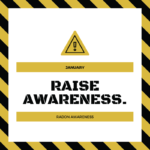 Among other events, January is officially declared as Radon Awareness Month.
Among other events, January is officially declared as Radon Awareness Month.
We Aging Life Care Specialists® ask a lot of questions – most pertain to the medical, social, and emotional conditions of an older adult, and the home environment. Now, in recognition of January’s theme, we are going even deeper in the home and descending to the basement.
Why the basement you ask? Because in some homes, across all fifty states, evil may be leaking from the ground. It’s colorless, odorless, invisible and can only be detected by testing. This mysterious element is called radon. It is a radioactive gas that comes from the decay of uranium found in the soil one’s house might be built on.
It typically moves up through the foundation to the air and enters one’s home through cracks, walls, construction joints or gaps in the foundation around pipes. A home traps radon inside, where it can build up. The ventilation and the air flow patterns in a house will affect how much radon will be pulled into different areas of the house. The age of the home does not make a difference.
According to the United States Environmental Protection Agency radon is the leading cause of lung cancer in non-smokers in the United States. The higher the radon level in a house, and the longer the exposure period, the greater the risk to the occupants.
Apologies for the scare, but the good news is that radon levels can be measured and if remediation is necessary, there are solutions. The place to start is with A Citizen’s Guide to Radon, published by the EPA. In a nutshell, the average radon concentration for homes in the United States is 1.3. It is when the radon levels, goes beyond 2 picoCuries per liter (the EPA will explain the jargon) that thought should be given to resolving the potential problem.
While you can hire a professional tester to determine the radon level, you can easily start with buying a do it yourself test kit available in hardware stores or online. You can also call 1-800-SOS-RADON (part of the EPA). This testing method consists of a small charcoal canister. The radon in the air is absorbed on the charcoal and the decay products can then be measured by a laboratory. The laboratory cost is usually incorporated in the cost of the canister. There may be some variations by state; for example, it is suggested by the New York State Department of Health, that two separate charcoal canister measurements be used before deciding to correct the situation. If mitigation is necessary the most common method is to have a vent pipe system and fan installed, which pulls radon from beneath the house and vents it to the outside. More information is available from the EPA at 1-800-55RADON.
So, why this article on radon? January is officially declared as Radon Awareness month. But beyond this, often, as Aging Life Care Specialists, we turn to our personal experiences when they can enhance the lives of those we help. Some years ago, with great excitement we closed on our dream weekend home in the woods. Surrounded by nature, deer leaping thru the woods beyond, a welcoming lake for rowing and swimming, what could be better? The answer would have been a tent for camping had we not taken care of the high radon level that was noted in the inspection report. As Aging Life Care Specialists, it is our goal to keep our clients safe at home. Checking for radon is another step to ensure their safety.
About the Author: Miriam Zucker, LMSW, ACSW, C-ASWCM, is the founder of Directions in Aging based in Westchester County, New York. For over two decades she has assisted families in customizing plans of care and developing effective strategies to meet the needs of senior adults.